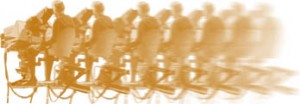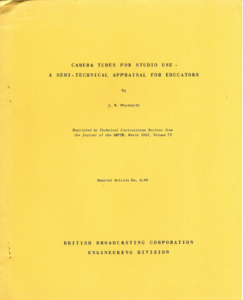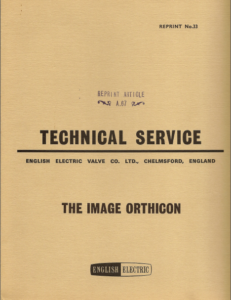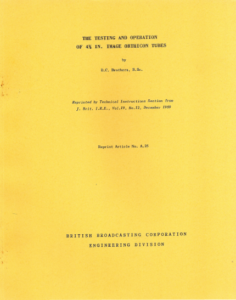This set of reprints is concerned with some of the various types of camera pick-up tubes in use in the BBC Television Studios around the Shepherd’s Bush area in the 1960s.
The main production studios at Television Centre were equipped with 4.5 inch Image Orthicon cameras from Marconi (MK IV) (TC2, TC3) and from EMI (TC4, TC5) (as at 1963!), Riverside R1 and R2 and the Television Theatre had 4.5 inch Image Orthicon Marconi Mk 3 cameras, and were upgraded to Pye Mk 5 during the decade.
Lime Grove started the decade with CPS Emitrons, which actually gave nicer (softer) facial tones than the Image Orthicons, but by the end of the decade these studios were re-equipped with 4.5 inch Image Orthicon EMI 203 monochrome cameras. Strange to think that “Doctor Who”, which started in Studio D Lime Grove, was shot with the just the second generation of the original electronic television camera pick-up tubes! (And it was the visual howl round of the CPS Emitron which produced the original “Doctor Who” titles!)
The Television Centre Presentation Suites Pres A and Pres B had EMI Vidicon cameras.
Each type of pick-up tube had its strengths and weaknesses,
| | The relative merits of vidicon and image-orthicon tubes are discussed with a minimum of technical jargon. Brief descriptions of the tubes are provided, but major attention is directed to picture quality, ease of operation, and economic factors. Either type of tube can be used successfully in educational TV studios, but the two types require significant differences in operating practices.
| Source: | the Journal of the SMPTE Vol 72 | | | Date: | March 1963 |
|
| | The image orthicon is [at time of the reprint] the most widely used television pick-up tube and will continue to be so for many years yet. The Image Orthicon produces a video signal by causing picture charge to modulate a scanning electron beam – the picture charge being produced and stored on a very thin membrane by photoelectrons, released by the projected optical image of the original scene from a continuous photocathode
| Source: | Electronic Components | | | Date: | October 1965
November 1965 |
|
| | The methods used by a broadcasting organization to check the performanceof image orthicon tubes are described. Aspects dealt with include: the transfer characteristic; sensitivity; contrast handling ability; signal/noise ratio; picture sharpness; geometrical distortion and linearity; microphony; uniformity of picture background; freedom from spurious effects; lag, movement blur, sticking, etc.; colour response; freedom from drift; ease of adjustment. Some conclusions are drawn on particular aspects of operating these tubes.
Please Note: page 778 was not printed on the original copy used to scan the article.
| Source: | Journal of the British Institution of Radio Engineers Vol.19 No.12 | | | Date: | December 1959 |
|
| | The photosensitive layer of the Plumbicon is an evaporated microcrystalline layer of lead monoxide. The most significant advantages of the Plumbicon are the low dark current, the high speed of response, which is independent of light intensity, and the high sensitivity. In the Plumbicon, every picture gives a signal that is dependent solely on the light-intensity projected on that particular picture element within the proper time-limits and is unaffected by disturbing effects known from other pickup tubes. This new tube is expected to prove especially suitable for color television.
| Source: | The Journal of the Society of Motion Picture and Television Engineers. Vol. 73 | | | Date: | June 1964 |
|
| | The “Plumbicon” has all the advantages of the vidicon but none of its fundamental disadvantages, and is therefore suitable for applications previously reserved for image orthicons. This makes it desirable to compare the picture quality and other characteristic features of the various types of camera tube as objectively as possible. The “Plumbicon” gives a very good account of itself for black-and-white television, and for colour television its superiority is unquestionable.
| Source: | Philips Technical Review Vol. 27, No. 1 | | | Date: | 1966 |
|
Back to top
Back to reprint index







